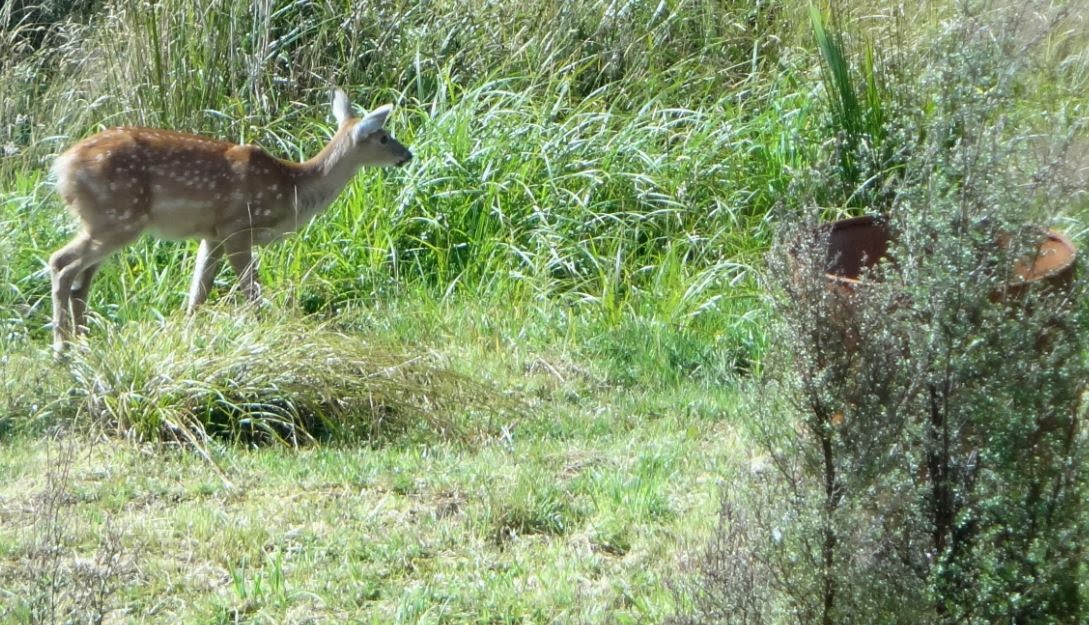The weather was cloudy and dry a couple of weeks ago when I walked to Ackers Point after work. The road winds around the coast, past Lonnekers Beach and Leask Bay and ends at the carpark. A walking track then leads down past the stone cottage (marked with a red x) at Harrold Bay and around the top of the cliffs, ending up at the lighthouse beacon.
 |
| Google Maps screenshot of Ackers Point peninsula |
There's a lot of history in this 3km walk. The 5m-high wooden lighthouse beacon was moved to Ackers Point in 1927 from The Neck, and replaced in 2007, still using the original light. The first time I walked to see it was in 2009 and I kept looking upwards to catch a glimpse of the 'lighthouse'; it was a surprise to see this squat wee building, barely showing over the bush canopy!
 |
| Ackers Point lighthouse beacon |
The lookout at the end of the track (at the left of the picture) is about 20m above sea level so a bit far for me to spot the little blue penguins bobbing about at dusk. There are several titi (muttonbird) burrows in this area and hopefully the kiwi that were released here last summer have stayed in the general area.
Ackers Cottage is back along the track at Harrold Bay and was built by Lewis Acker around 1835. It originally had two rooms and the stone, from an Invercargill quarry, was set in clay and pointed with crushed sea shells. The original slate roof has since been replaced with corrugated iron. Lewis and Mary Acker had 9 children - I can picture them playing around the house and beach whilst their father tended to his boats and their mother was fully occupied with household duties and babies.
In the early 1860s the cottage was owned by Captain James Harrold (originally from the Orkney Islands), and his Canadian wife, Agnes. When they first arrived in Stewart Island in 1861 they set up home in Port William where they cured fish but moved to the stone cottage after a short time and set up a shop and shipbuilding business, then a guest house called Travellers' Rest, a Category 1 historic building currently being restored.
Agnes was a resourceful woman and a competent nurse. She managed the guest house, cared for her own and foster children, was the island's midwife and also tended to the sick and injured often walking long distances to the sawmills. She died in 1903, five years after James, and they are both buried in the Halfmoon Bay Cemetery.
I can't find many facts about Jensen Bay although I'm picking it was named after Hans and Mary (nee Leask) Jensen who bought Travellers' Rest in 1910. Their daughter, Olga, was a teacher and keen birdwatcher and also a foundation member of the Ornithological Society of New Zealand. She received the Queen's Service Medal in 1979, 10 years before her death. (Doreen Gilchrist. 'Sansom, Rosa Olga', from the Dictionary of New Zealand Biography. Te Ara - the Encyclopaedia of New Zealand, updated 29-Jan-2014 URL:
http://www.TeAra.govt.nz/en/biographies/5s2/sansom-rosa-olga
Leask Bay was named after another Orkney Islander, Tom Leask, who settled there with his wife, Dinah. Tom set up a shipbuilding and repair business and was also involved in commercial fishing. They had nine children, one of which (Alex) built a crib in the bay in the 1920s - next time I'm down that way I'll take a photo of it if it is still standing.
I'm haven't heard of Little Bay that's shown on the Google map above so I'll move slightly to the left and Lonnekers Beach - this was named after 'Fred' Lonneker, a German, and his wife, Hannah (Dinah Leask's sister) who opened the island's first licensed hotel in 1875.
It's fun learning the history of the names and in my next blog I'll fill you in with the Norwegian link, in preparation for our Norsk Feiring weekend in early April - see
here (opens in new window) for a wee taster.















































